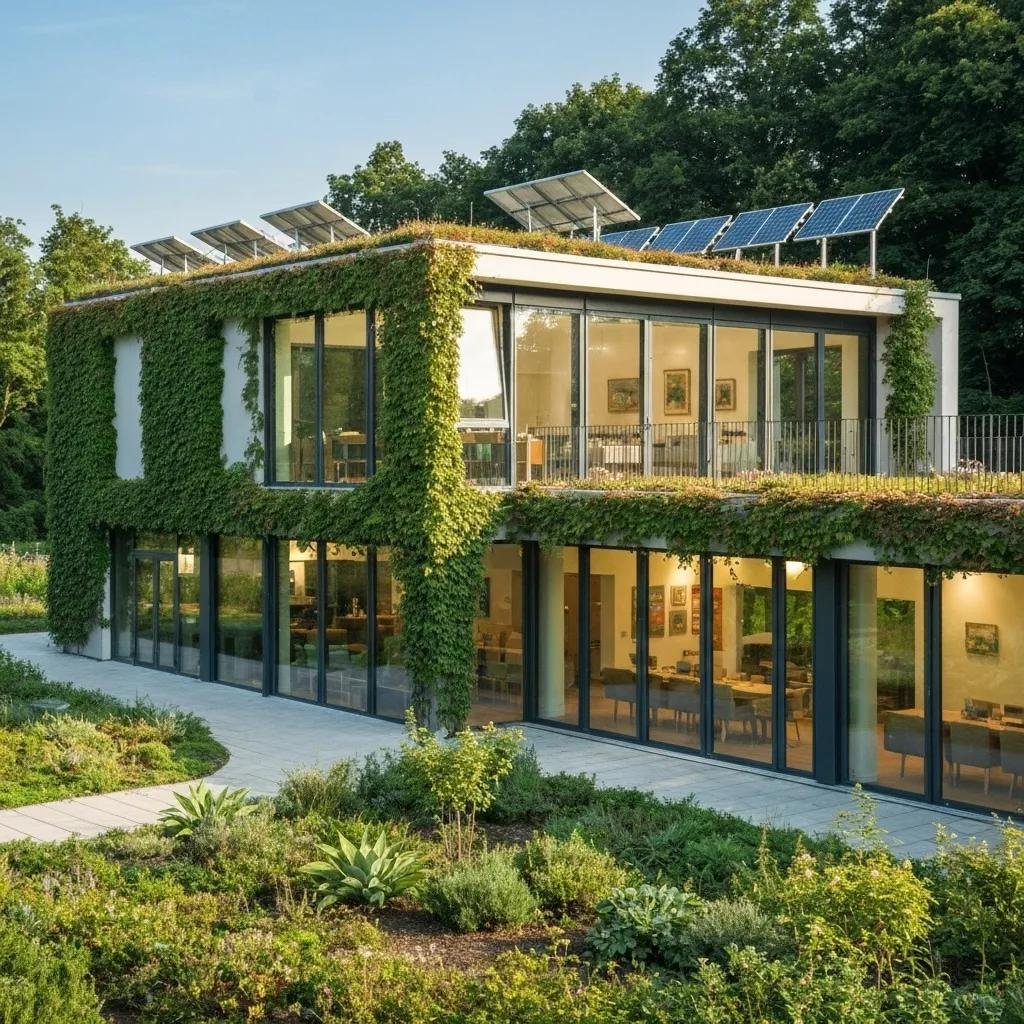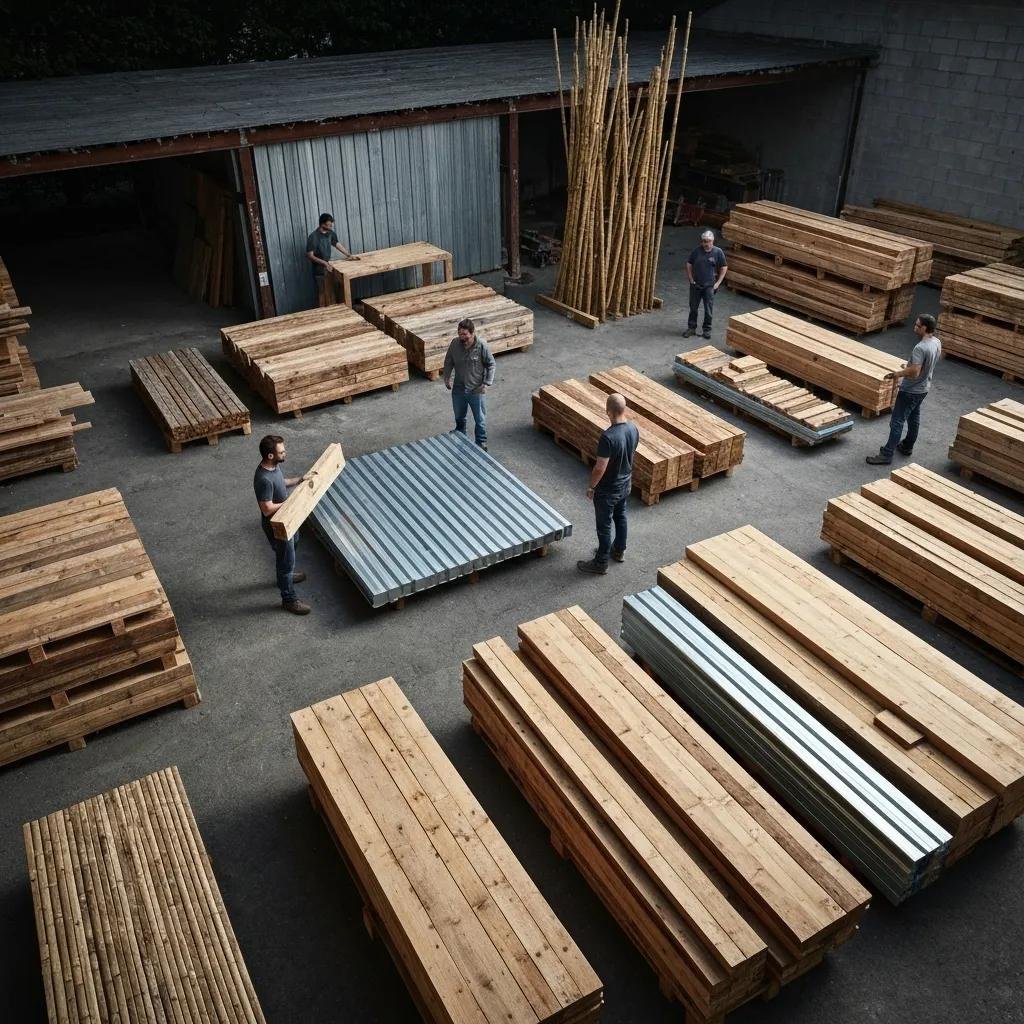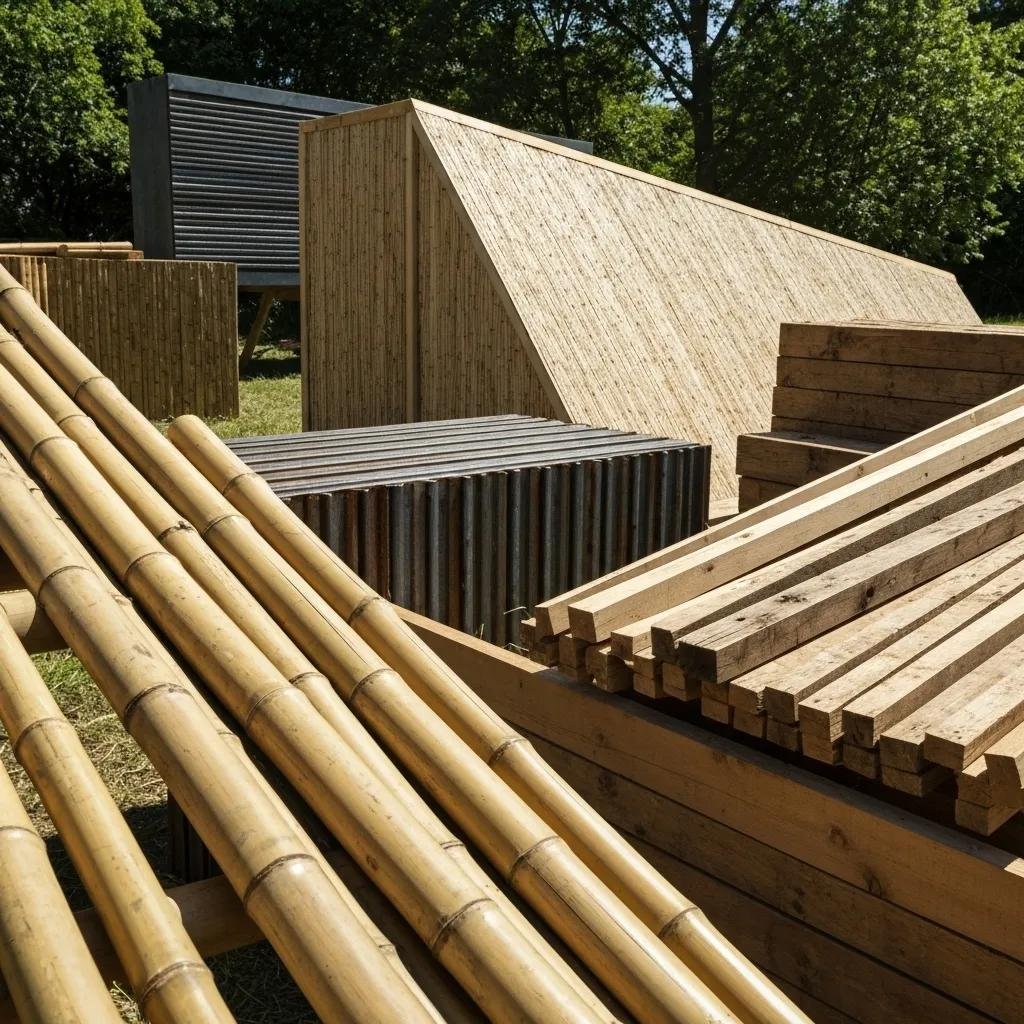Eco-Friendly Construction Materials for Sustainable Building
Buildings account for nearly 40 percent of global CO₂ emissions, making material choices a decisive factor in climate impact and resource use. This article explains how eco-friendly construction materials reduce embodied carbon, improve energy performance, enhance indoor health, and lower long-term costs. Readers will discover key characteristics, top benefits, leading materials, local sourcing strategies, implementation steps, challenges and solutions, future trends, and how green buildings connect with professional air duct cleaning and commercial cleaning services. Businesses seeking both sustainable construction guidance and facility maintenance insights will find actionable takeaways to support greener projects and healthier environments.
What Are Eco-Friendly Construction Materials and Their Key Characteristics?
Eco-friendly construction materials are sustainable alternatives to conventional supplies that minimize environmental harm by using renewable resources, reducing embodied carbon, and avoiding toxic substances. These materials support circular economy principles, conserve raw materials, and often deliver enhanced performance in thermal regulation or moisture control, setting a foundation for truly green building practices.
How Do Eco-Friendly Materials Support Sustainable Building?
Eco-friendly materials support sustainable building by reducing embodied carbon through recycled content or rapid renewability, improving energy efficiency with superior insulation properties, and safeguarding occupant health by eliminating volatile organic compounds (VOCs). This holistic approach not only cuts greenhouse gas emissions but also fosters buildings that last longer and require less operational energy, driving down lifetime environmental impact and enabling more resilient structures.
What Are the Most Common Types of Green Building Materials?
The following list highlights core categories of eco-friendly materials widely used in sustainable construction:
- Bamboo, prized for its rapid growth and high strength-to-weight ratio
- Recycled steel, offering exceptional durability and resource circularity
- Hempcrete, a carbon-negative composite with natural insulation properties
- Reclaimed wood, preserving historical value while reducing deforestation
- Cork and sheep’s wool insulation, delivering moisture buffering and thermal control
Each material combines environmental benefits with proven applications, setting the stage for deeper comparison of performance attributes.
How Is Embodied Carbon Related to Eco-Friendly Materials?
Embodied carbon measures the total CO₂ emissions associated with extracting, processing, transporting, and installing a material. Eco-friendly materials often target low embodied carbon by using recycled inputs (like reclaimed steel) or sequestering carbon during growth (such as bamboo and hemp). Lowering embodied carbon directly reduces a building’s upfront emissions footprint and aligns construction projects with net-zero goals.
The Role of Building Materials in Reducing Carbon Emissions
Research indicates that the selection of construction materials significantly impacts a building’s carbon footprint, with eco-friendly options offering substantial reductions in embodied carbon. These materials often utilize recycled content or sequester carbon, aligning with net-zero goals and reducing upfront emissions.
Ramesh, T., Prakash, R., & Shukla, S. (2010). Life cycle assessment of buildings: A review. Building and Environment, 45(6), 1508-1516.
This research supports the article’s claims about the importance of eco-friendly materials in reducing a building’s environmental impact.
What Are the Top Benefits of Using Sustainable Construction Materials?

Sustainable construction materials deliver measurable advantages across environmental, health, and economic dimensions by lowering life-cycle impacts, improving occupant well-being, and unlocking operational savings.
The Benefits of Using Sustainable Construction Materials
Research highlights the advantages of sustainable construction materials, including reduced environmental impact, improved occupant well-being, and long-term cost savings. These materials contribute to waste reduction, support the circular economy, and often have lower lifecycle costs due to reduced maintenance and energy consumption.
Cole, R. J. (1999). Life-cycle costing and the environment: A case study of building materials. Building and Environment, 34(3), 271-279.
This research supports the article’s claims about the environmental, health, and economic benefits of using sustainable construction materials.
How Do Eco-Friendly Materials Improve Energy Efficiency in Buildings?
Eco-friendly materials improve energy efficiency by enhancing a building envelope’s thermal resistance, reducing heating and cooling loads, and stabilizing indoor temperature swings.
| Material | R-Value (per inch) | Energy Performance Benefit |
|---|---|---|
| Bamboo Insulation Panels | 3.2 | Minimizes heat transfer in walls |
| Hempcrete Blocks | 2.4 | Regulates temperature with mass |
| Sheep’s Wool Insulation | 3.5 | Controls moisture and thermal drift |
These high-performance insulators lower HVAC energy use, translating into substantial utility savings and reduced greenhouse gas emissions.
Energy Efficiency and Sustainable Building Materials
Studies have shown that using materials with high thermal resistance, such as bamboo insulation panels and hempcrete, can significantly improve a building’s energy efficiency. These materials help to regulate indoor temperatures, reducing the need for heating and cooling and leading to lower energy consumption.
Asdrubali, F., Baldinelli, G., & Bianchi, F. (2013). Life cycle assessment of building materials: A review. Building and Environment, 69, 20-35.
This citation reinforces the article’s discussion on how green materials enhance energy efficiency in buildings.
In What Ways Do Green Materials Enhance Indoor Air Quality?
Green materials boost indoor air quality by eliminating harmful VOCs, resisting mold growth, and integrating breathable surfaces that balance humidity levels. Unfinished reclaimed wood and natural clay plasters absorb excess moisture, while low-VOC paints prevent off-gassing. These combined attributes create healthier environments with fewer allergens and irritants.
How Do Sustainable Materials Contribute to Waste Reduction and Circular Economy?
Sustainable materials integrate recycled content, facilitate deconstruction, and support reuse, thus minimizing construction and demolition waste. Using reclaimed timber or recycled steel diverts resources from landfills, while modular panels and engineered wood products enable disassembly and repurposing. This closed-loop strategy reduces raw-material demand and reinforces circular economy principles.
What Are the Long-Term Cost Savings of Using Eco-Friendly Materials?
Though upfront investment can be higher, eco-friendly materials generate significant cost savings over time through reduced energy bills, lower maintenance requirements, and increased asset value. Durable finishes like recycled steel and treated reclaimed wood often outlast conventional alternatives, further compressing lifecycle expenditures and delivering stronger returns on investment.
Which Eco-Friendly Construction Materials Are Most Effective and Why?
Leading materials excel by combining ecological benefits with robust performance, enabling project teams to meet sustainability targets without compromising quality.
| Material | Key Property | Primary Use |
|---|---|---|
| Bamboo | Rapid renewability | Flooring & structural panels |
| Recycled Steel | High recyclability | Framing & support beams |
| Hempcrete | Carbon-negative matrix | Insulating wall systems |
| Reclaimed Wood | Resource conservation | Finishes, cladding, beams |
These materials illustrate how renewability, recyclability, and carbon management converge to elevate sustainable building standards.
What Are the Properties and Uses of Bamboo in Construction?
Bamboo is a grass species with exceptional tensile strength and fast maturity, making it ideal for flooring, decorative paneling, and lightweight structural components. Its high CO₂ absorption rate and minimal processing requirements yield one of the lowest embodied carbon footprints among natural materials, supporting both climate and resource conservation objectives.
How Does Recycled Steel Support Sustainable Building Practices?
Recycled steel boasts nearly infinite recyclability while retaining structural integrity, offering a low-embodied-carbon alternative to new metal. It excels in framing, trusses, and reinforcement applications, enabling strong, durable structures that align with circular material flows and strict environmental mandates.
What Are the Insulation Advantages of Hempcrete and Green Insulation Options?
Hempcrete blends hemp hurd with lime binder to form breathable, moisture-regulating walls that sequester carbon during curing. Comparable green insulation choices such as cork panels and cellulose fibers offer fire resistance, sound attenuation, and thermal stability, collectively reducing energy demand and enhancing occupant comfort.
Why Is Reclaimed Wood a Sustainable Choice for Construction?
Reclaimed wood repurposes salvaged beams, siding, and timber from decommissioned structures, preserving embodied energy and reducing pressure on forests. Its distinctive patina adds aesthetic character while cutting waste and materially supporting historical preservation and circular economy practices.
How Do Low-VOC Paints and Energy-Efficient Glass Improve Building Sustainability?
Low-VOC paints eliminate toxic off-gassing to protect indoor air, and energy-efficient glazing systems (e.g., double or triple pane, low-emissivity coatings) dramatically cut solar heat gain and thermal loss. Together, they maximize occupant health and minimize HVAC loads, reinforcing green building certification criteria.
How Can Businesses Source and Implement Eco-Friendly Building Materials Locally?

Local sourcing reduces transportation emissions, supports regional economies, and ensures timely project delivery while aligning with sustainable procurement policies.
Where Are the Best Local Suppliers of Sustainable Materials in Houston?
Houston hosts multiple distributors specializing in green lumber yards, recycled metal brokers, and natural insulation providers. Partnering with regional suppliers shortens supply chains and allows businesses to inspect material quality before purchase, bolstering both environmental and operational performance.
What Certifications and Standards Ensure Material Sustainability?
Certifications like LEED, BREEAM, and the WELL Building Standard validate material sustainability through criteria such as recycled content, lifecycle assessments, and VOC limits. Products bearing Forest Stewardship Council (FSC) or Cradle to Cradle labels deliver added assurance of environmental responsibility and traceability.
How Do Cost and Availability Affect the Adoption of Green Materials?
Higher upfront costs and limited regional stock can slow adoption, yet bulk purchasing, phased integration, and value engineering help mitigate price barriers. Early engagement with suppliers and flexible design specifications improve availability by forecasting demand and fostering material innovation partnerships.
What Are Practical Steps to Implement Eco-Friendly Materials in Construction Projects?
Businesses can follow these actionable steps to integrate sustainable materials:
- Conduct a material audit to benchmark current specifications.
- Prioritize high-impact substitutions (e.g., recycled steel for structural framing).
- Source certified products from accredited local suppliers.
- Train project teams on handling and installation best practices.
Implementing these measures lays groundwork for measurable sustainability gains and supports project certification goals.
What Challenges Exist in Using Eco-Friendly Construction Materials and How Can They Be Overcome?
Deploying green materials introduces hurdles in cost, supply chain complexity, and stakeholder awareness that must be strategically addressed.
Why Are Initial Costs Higher for Sustainable Materials?
Eco-friendly materials often require specialized manufacturing or certification processes that raise production costs. However, lifecycle savings in energy, maintenance, and potential incentives or tax credits frequently offset these premiums, making total cost of ownership more attractive over project lifespans.
How Does Limited Availability Impact Material Selection?
Regional scarcity of certain green products can delay construction schedules and inflate prices. To overcome this, project teams can specify performance-based criteria rather than brand-specific items, widen supplier networks, and engage early on to secure bulk orders or pilot new sustainable product lines.
What Strategies Increase Awareness and Adoption of Green Building Practices?
Education campaigns, demonstration projects, and collaboration with industry bodies accelerate green adoption. Hosting site tours, publishing performance data, and leveraging case studies foster trust among stakeholders and help showcase the tangible benefits of sustainable materials in real-world applications.
How Can Collaboration Between Builders and Suppliers Improve Sustainable Construction?
Partnerships enable co-development of innovative materials, share risk on new product trials, and streamline logistics. By aligning specifications, quality standards, and delivery schedules, builders and suppliers can reduce waste, optimize inventory, and bring cost-effective eco-friendly solutions to market faster.
What Is the Future Outlook for Eco-Friendly Construction Materials and Sustainable Building?
The sustainable construction sector is poised for rapid expansion, driven by technological advances, policy mandates, and market demand for resilient, low-impact infrastructure.
How Will Market Growth Influence Material Development by 2034?
Projected market growth rates above 11 percent annually will incentivize R&D in low-carbon concretes, advanced bio-composites, and 3D-printed building components. Economies of scale and competitive innovation will drive down costs and expand green material portfolios.
What Emerging Materials and Technologies Are Shaping Green Construction?
Novel bio-materials such as mycelium composites, self-healing concretes, and recycled plastic bricks are entering pilot phases. Digital fabrication, parametric design, and AI-driven performance modeling further optimize material use and reduce waste.
How Will Circular Economy Principles Transform Building Practices?
Circular economy frameworks will shift focus from single-use construction cycles to continuous reuse, remanufacturing, and adaptive reuse. Material passports and digital tracking will facilitate efficient deconstruction and repurposing, minimizing resource extraction.
What Role Do Certifications and Regulations Play in Future Adoption?
Stricter building codes and evolving certification criteria will mandate lower embodied carbon thresholds and transparent supply chains. Government incentives, carbon pricing, and ESG reporting requirements will further accelerate uptake of eco-friendly construction materials.
How Do Eco-Friendly Construction Materials Connect to Building Maintenance and Cleaning Services?
Integrating green materials with professional maintenance ensures performance longevity, healthy indoor environments, and sustained resource efficiency. Proper cleaning and upkeep safeguard the integrity of sustainable systems and amplify their environmental advantages.
Why Is Air Duct Cleaning Important for Sustainable Buildings?
Thorough air duct cleaning removes dust, mold spores, and allergens that can accumulate in ventilation systems of green buildings. Maintaining clean ducts supports indoor air quality standards set by green certifications and enhances HVAC efficiency by preventing airflow restrictions.
How Do Commercial Cleaning Services Support Eco-Friendly Facilities?
Commercial cleaning services tailored to sustainable facilities use eco-certified detergents, microfiber tools, and waste-minimizing processes. These practices protect sensitive materials—such as low-VOC paints and natural plasters—while upholding high hygiene standards without introducing harmful chemicals.
What Are Best Practices for Maintaining Green Building Materials?
Effective maintenance includes regular visual inspections, gentle cleaning techniques, and environmental controls that prevent moisture damage or UV degradation. For instance, reclaimed wood finishes benefit from breathable sealants and periodic polishing, ensuring both preservation and material breathability.
How Can Sustainable Construction and Cleaning Services Work Together Locally?
Local builders and cleaning professionals can coordinate maintenance schedules to coincide with seasonal inspections, enabling timely repairs and preventing minor issues from escalating. Joint training programs foster shared expertise in handling eco-friendly materials, and facility managers benefit from integrated service agreements that combine construction oversight with specialized cleaning—promoting healthier, longer-lasting green buildings.
Sustainable construction materials reduce environmental impact, elevate occupant health, and deliver long-term economic value. From bamboo and recycled steel to advanced bio-composites, each green option addresses specific performance and carbon-reduction targets. Overcoming cost and availability hurdles through strategic sourcing, collaborative partnerships, and phased implementation drives wider adoption. By pairing green materials with professional air duct cleaning and commercial cleaning services, businesses ensure that sustainable buildings perform optimally, maintain indoor air quality, and uphold environmental commitments for decades to come.





